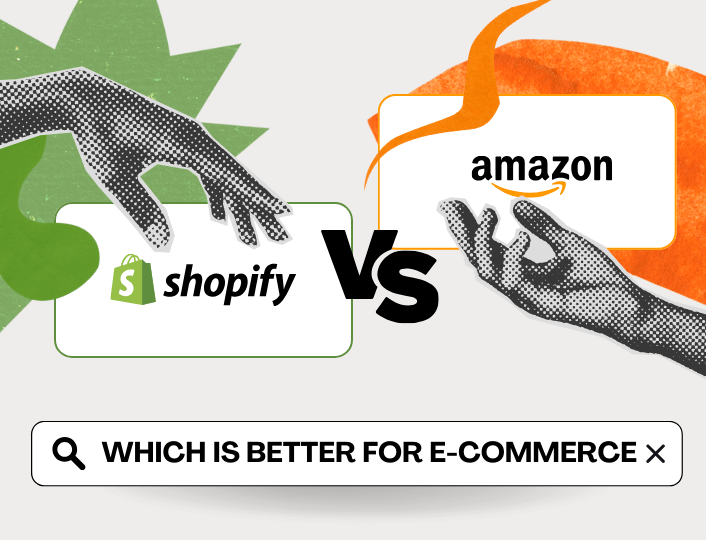Shopify and Amazon are both powerful e-commerce tools. For e-commerce starters, however, you should only begin on one platform before expanding to a second. Curious about the differences between these platforms? You are in the right place.
Over the years, e-commerce has witnessed tremendous growth. Retail e-commerce generated $5.717 trillion in revenue in 2021 and is expected to hit $6.31 trillion by the end of 2023. E-commerce platforms have made this possible.
Although there are a ton of them out there, Shopify and Amazon stand out.
Both platforms offer entrepreneurs and businesses the opportunity to sell products online, but they cater to distinct needs and come with unique advantages and disadvantages.
In this guide, we will explore the core differences and characteristics of these two e-commerce giants. This will help you make an informed choice that aligns with your business goals and aspirations.
Shopify vs Amazon for E-commerce: A Comprehensive Comparison
Shopify and Amazon are both powerful e-commerce tools, but they serve different purposes and have distinct strengths and weaknesses. While the former is an e-commerce platform, the latter is a marketplace.
E-commerce platforms give you absolute control over your online store. This includes customization, pricing, inventory management, store policy, and so on.
On the other hand, a marketplace is a website that hosts multiple vendors and regulates the activities of each store. Store owners do not have absolute control over their stores as the marketplace handles activities such as inventory management, customization, etc.
With that in mind, here’s a detailed Shopify vs Amazon comparison:
Shopify
Shopify is a dedicated e-commerce platform that empowers sellers to create and manage online stores. It offers a suite of functions for entrepreneurs and businesses looking to build their brands and sell products independently.
Shopify allows you to create a website, customize it, manage product and pricing, process payments, fulfill orders, and more.
However, to get eyeballs on your store, you need to promote your store by yourself using various marketing methods such as email, SMS, influencer, affiliate marketing, and more.
Thankfully, Shopify provides several tools to make this process easier. Plus, it allows for marketing automation to further lessen your workload. You can find whatever you need on the Shopify app store.
Amazon
Amazon is an online marketplace that connects sellers with millions of potential buyers. With over 2.2 billion monthly visitors, sellers can leverage the existing customer base and infrastructure to grow their e-commerce business.
Amazon provides a platform for sellers to list and sell their products without doing too much. The marketplace handles payment processing, inventory, and order fulfillment through Fulfillment by Amazon. And it offers various tools that foster growth in sales.
Amazon provides standardized templates for product listings and limits your customization abilities, unlike Shopify.
Key Comparison Factors
- Control over branding
- Customization
- Ease of use
- Product listing
- E-commerce features
- Pricing
- Customer support
Shopify vs Amazon: Control Over Branding
Shopify gives you total control over your brand. You can design and customize your online store to reflect your brand identity. This enables you to create a unique and distinctive customer experience.
You can choose your domain name, design your website, and tailor it to your specific branding requirements. This means that you get to decide how you want customers to perceive your business.
On the other hand, while you can create a brand presence on Amazon, there is a limit to what you can do. Product listings follow a standard pattern, and there’s less room for branding and customization, unlike the standalone Shopify stores.
Amazon’s marketplace has a consistent design template every seller must follow. And your branding is limited within the constraints of the Amazon ecosystem.
Is branding control a big deal for your business? Bank with Shopify.
Shopify vs Amazon: Customization
Shopify is known for offering a high level of customization. It lets you build your website using the drag-and-drop website builder. It also provides a variety of themes, and templates and gives you extensive design control.
These themes and templates can be easily customized to reflect your brand’s style and messaging. You can take your customization a step further by integrating third-party tools in your store to get better results. This is a great way to enhance and extend your store’s functionality and features.
Speaking of third-party tools, the Adoric pop-up app is the perfect tool for increasing sales and boosting website engagement.
Amazon, in contrast, provides less room for customization compared to Shopify. It focuses on maintaining a consistent shopping experience for its customers, which means a more standardized approach to product listings and storefronts.
While you can personalize your Amazon store to some extent, you must follow the laid down rules. This, however, limits your flexibility in terms of customization.
Shopify vs Amazon: Ease of Use
Shopify offers a clear-cut onboarding process. It’s accessible to beginners and doesn’t require advanced technical skills.
When it comes to customization, it gives you the flexibility to play around while you decide what works best for you. The drag-and-drop builder makes it easy to create a unique online store.
On top of that, managing products and inventory is straightforward. Shopify offers 24/7 support, extensive documentation, and a helpful community to assist you whenever necessary.
As for Amazon, its initial setup is straightforward, but as you delve into its marketplace, you may encounter some complexity. However, since Amazon regulates website performance, you don’t have to worry about losing customers due to poor website design.
In addition, Amazon manages your inventory, fulfills orders, processes payment, and provides seller support. This makes it easy to use and a good choice if you do not have the resources to manage a standalone e-commerce store.
Shopify vs Amazon: Product Listings
On Shopify, You have total control over product listings. You can optimize your product listings for search engines and create unique content to attract and convert customers.
Shopify only provides the resources for hosting and managing your store. However, you get to market your products independently.
Since Amazon is a marketplace, all you have to do is set up a store and follow a template for product listings. With millions of buyers visiting the marketplace, you can get customers without ads if your store is well-optimized and offers what customers need.
However, this type of structure means that you’re competing with several other sellers selling the same products as you. This calls for the need to put in additional marketing efforts to increase your visibility.
Shopify vs Amazon: E-commerce Features
Shopify is a dedicated e-commerce platform that offers a suite of features for online stores. These features can help you build an e-commerce website from scratch and manage it successfully.
They include a website builder, customizable website design, a wide range of themes and templates, Point-of-sales (POS), Shopify Fulfillment Network, third-party apps, plugins, and more.
As for Amazon, considering that it is primarily a marketplace, its e-commerce features are designed for product listings and sales. Amazon offers tools for product listings, standardized templates for creating stores, a dedicated order fulfillment service ( Fulfillment by Amazon, or FBA), and more.
Amazon processes payment for sellers on its platform, making it easier to manage an online store, providing a convenient system for transactions. It also provides access to a vast and established customer base, potentially resulting in quicker sales and revenue.
Shopify vs Amazon: Pricing
Selling on Shopify or Amazon comes at a cost. While Shopify pricing might come off as being relatively high, processing a high quantity of sales in a month can make it worth it. Below is the pricing breakdown that will help you choose between Shopify and Amazon.
Shopify offers a 3-day free trial and a $1 subscription on all plans for three months.
-
- Starter plan: costs $5 per month. This plan is for people who want to sell their products through social media and Messenger without the hassle of managing a standard website.
- Basic plan: costs $32 per month. This plan is for individuals and small businesses. It gives you access to basic reports, and you can add up to 2 staff accounts.
- Retail plan: costs $89 per month. This is for businesses with physical and online stores. This plan allows you to add multiple POS logins.
- Shopify plan: costs $92 per month.
- Advanced plan: costs $399 per month. Add up to 15 staff accounts.
- Shopify Plus: costs $2000 per month. Best for enterprises.
Aside from the starter plan, others give you access to quite a number of e-commerce features.
Amazon, on the other hand, offers two major pricing plans alongside referral fees and other charges.
- Individual plan: costs $0.99 per item sold.
- Professional plan: costs $39.99 per month.
In addition to the selling plans, fulfilling orders through Amazon fulfillment service (FBA) comes at a cost depending on the product, weight, and delivery location.
Also, for every item you sell through referral, Amazon takes a specific percentage ranging from 8% to 45% or a minimum fee of $0.30. There are also other fees like rental book service fees, closing fees, high volume listing fees, and refund administration fees.
Shopify vs Amazon: Customer Support
Shopify offers better customer service when compared to Amazon. The e-commerce platform provides a range of customer support options, including 24/7 live chat, email support, how-to guides, blogs, and business courses.
Their support team is responsive and always available to help. Shopify also hosts a vibrant community forum for its users.
While Amazon provides seller support and useful resources, getting a direct response from the support team can be a hassle. You may have to simply rely on the resource center to find a solution or painstakingly navigate the website to find the chatbot.
Hence, in this Shopify vs Amazon comparison, Shopify is a better option if customer support is of the essence to you.
Final verdict
We recommend Shopify for their specificity towards e-commerce and prompt customer support, amongst other reasons. However, your business goals would determine your eventual choice.
Opting for Shopify? Find out how Adoric helps Shopify merchants like you reach more customers and boost patronage.




